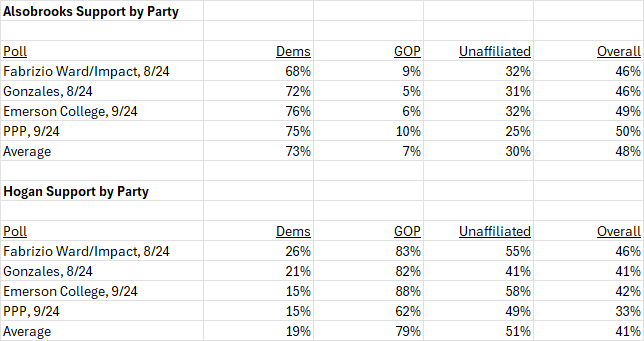By Adam Pagnucco.
With Maryland’s most consequential U.S. Senate election in recent memory coming up, here is a question the state’s entire political establishment is asking: how could the Republican nominee, Larry Hogan, win?
Lots of strategic folks have opinions on messaging, money, field, media and all the other factors that go into winning campaigns. Like everyone else, I have opinions on those things too. But for this column, I’m going to skip that stuff and do what we do best:
MATH.
First, let’s start with five publicly released polls on this race since June. Here are their summaries:
Public Policy Polling, June
June 29-30, 635 voters
Margin of error +/-3.9
Alsobrooks 45, Hogan 34
Alsobrooks +11
AARP/Fabrizio Ward/Impact Research, August
August 14-20, 1,258 likely voters
Margin of error +/-3.5
Alsobrooks 46, Hogan 46
Tie
Gonzales Research, August
August 24-30, 820 registered voters
Margin of error +/-3.5
Alsobrooks 46, Hogan 41
Alsobrooks +5
Emerson College, September
September 12-13, 890 likely voters
Margin of error +/-3.2
Alsobrooks 49, Hogan 42
Alsobrooks +7
Public Policy Polling, September
September 16-17, 543 voters
Margin of error +/-4.2
Alsobrooks 50, Hogan 33
Alsobrooks +17
At first glance, Maryland appears to have one statewide general electorate. In fact, any political professional worth hiring will see that the state has many general electorates. They can be divided by geography, age, race, gender and much, MUCH more. In a deafeningly Blue vs Red race, with control of the entire U.S. Senate possibly on the line, one factor may just rise above the rest: party affiliation. Each party is simultaneously on offense, trying to take the Senate for itself, and also on defense, trying to hold the Senate in case the other party’s presidential nominee wins. And each party is relentlessly drilling that message to its members.
Over the last three presidential general elections, Maryland’s average partisan distribution of voters has been 56% Democratic, 27% Republican and 16% others (mostly unaffiliated). That lays out the relative tasks of the candidates. Prince George’s County Executive Angela Alsobrooks can win by holding all the Democrats. Hogan can only win with a coalition of voters from all three groups. His job is more complicated than hers.
Let’s start with party loyalty to each candidate. The table below shows that for each of the last four polls, which were taken in August and September.

Alsobrooks is getting roughly three-quarters support from her own party. That’s not quite enough to win outright and demonstrates her key problem: Hogan’s popularity among a portion of Democrats. Hogan is getting more than 80% support from the GOP in most of these polls. (The latest one from Public Policy Polling is an outlier that I question; subtracting the libertarian candidate gets Hogan to 76%.) But the fact that Hogan’s support is not even higher in the GOP illustrates one of his key problems: his rupture with supporters of Donald Trump, whom he openly disdains.
Let’s broaden the above cut to look at average support by party for both candidates.

Alsobrooks doesn’t have a lock on victory, but her support by roughly three-quarters of her own party plus nearly a third of unaffiliated voters has her close to a win. In contrast, look at Hogan’s falling support among Democrats – down from 26% in the first poll to 15% in the two most recent polls. This probably reflects the mounting attacks on Hogan by Alsobrooks and her party, many of which are centered on abortion.
Hogan needs Democratic support to win. If all he gets is 15%, the math of past partisan voting strongly suggests that he will lose. In that range, his total percentage will probably be in the low 40s.
So what does Hogan need to win? Given the partisan distribution of Maryland’s presidential general election voting, this is his path.
Republicans: 90% support. This would require Trump loyalists to hold their noses and GOP voters to ignore the libertarian candidate, Mike Scott. Aside from the outlier Public Policy Polling poll in September, Hogan is close to this with more than 80% support.
Unaffiliated/Other Voters: 65% support. Hogan is averaging 51% among this group with a high mark of 58% in the September Emerson College poll. If I were in the Hogan campaign, I would want to know the views of this group – or groups – on which party they would like to control the Senate. If these unaffiliated voters lean towards the Democrats without actually being Democrats, that’s a problem. If they don’t care much about party control of the Senate, that’s probably a plus for Hogan.
Democrats: 25% support. Hogan broke this mark in the August Fabrizio Ward/Impact poll, but as stated above, it has been declining since. This is a huge problem for Hogan. How does he get a quarter of the Democrats while still getting 90% of the Republicans when most Republicans are loyal to Trump and most Democrats despise him? Hogan is a talented politician but that’s a heavy lift, even for him.
If Hogan hits the above targets, he will get 49% of the vote. With a libertarian in the race, that might be enough to pull out a historic squeaker of an election.
Poll numbers will move around a lot. Anonymous Senate Republican sources told the Hill that they have seen unpublished polling holding that Hogan and Alsobrooks are tied. But what I will be watching in future polls is Hogan’s support among each of the three partisan groups. If he fails to meet the 90-R, 65-U and 25-D target I laid out above, or does not make up for an under number in one group with an over number in another, he will lose. As for Alsobrooks and the Democrats, they will aim to drive Hogan’s support in their party as low as it can go.
The relative success of these strategies will determine the identity of the next U.S. Senator from Maryland.
